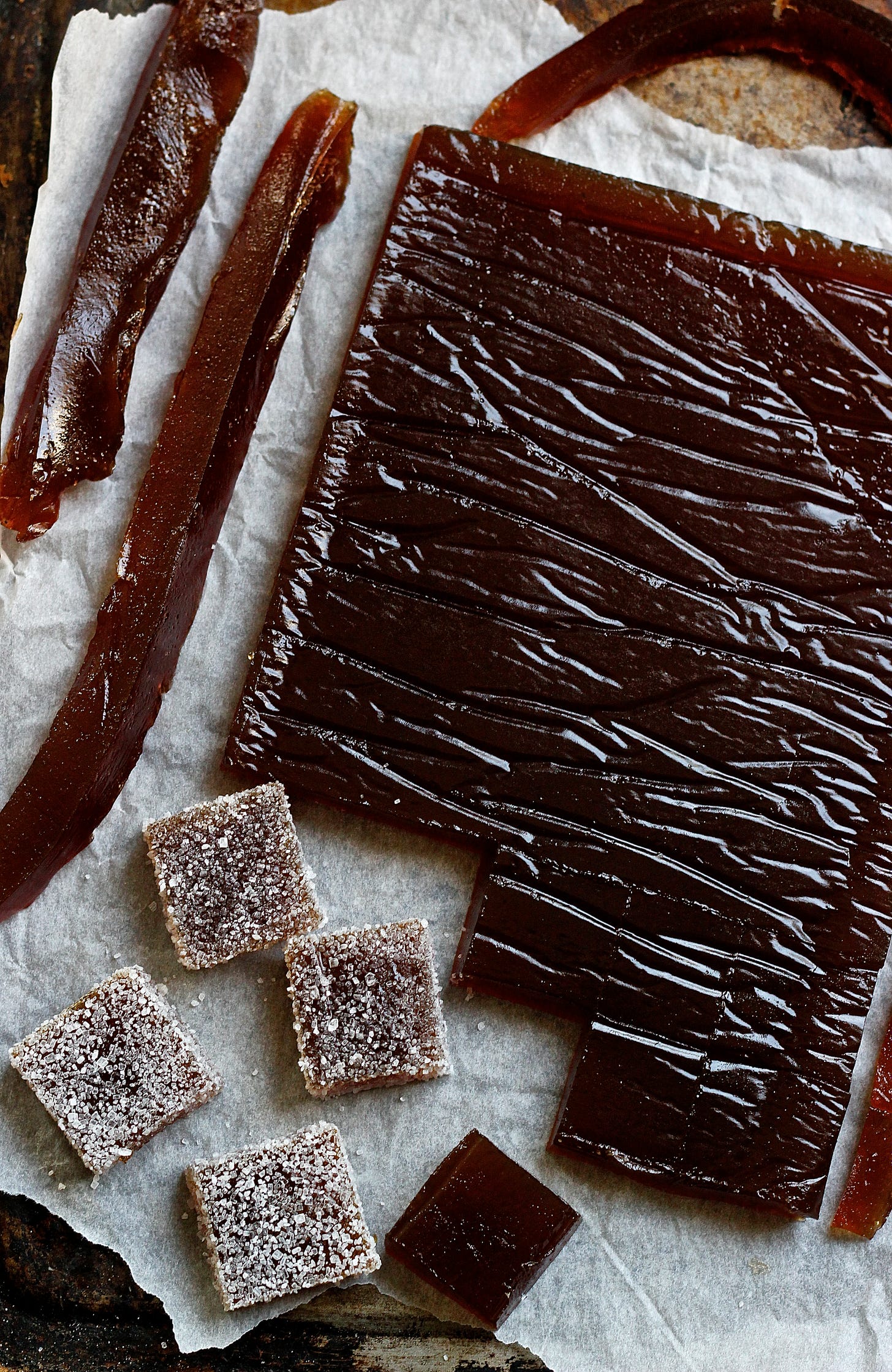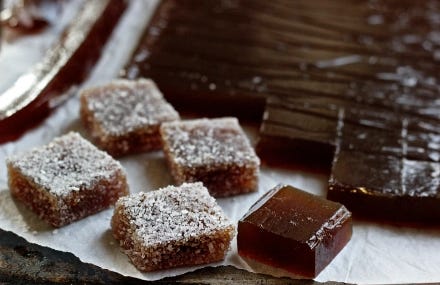Ingredient Spotlight: Tamarind
"A prune sucking on a lemon" (Niki Segnit) - and a recipe for Tamarind Pâte de Fruit
Hello, and welcome to Newsletter No 42 here on Substack! Thank you for stopping by. If you are already subscribed - THANK YOU! Seeing thousands of you read my newsletters each month means the world to me! And if you are not yet a subscriber, hit the link below if you are interested in recipes as well as tips and tricks to make the most of our increasingly eclectic pantries and a good dose of my at times random musings about all things food!
❤️ Also, did you know that if you hit the HEART at the top or bottom of this post, it makes it easier for people to find this newsletter? (And also puts huge smile on my face!)
This week we are back with another edition of my Ingredient Spotlight series. After already covering Hibiscus, Labneh, Sumac and Turmeric, today we will talk about all things Tamarind and how to incorporate Tamarind into delicious baked goods and desserts.
I love Tamarind for its mouth-puckering fruity tartness and it’s a good reminder that when you want to add some acidity to your baked goods and desserts there are many more options besides using citrus fruits!
There is quite a lot to cover when it comes to Tamarind and as I was writing this post I came across this excellent primer on Tamarind on Epicurious. So if you want to learn more about the different types of Tamarind that exists (not all Tamarind is sour!) and the different Tamarind products you can buy (pulp! with seeds or without! tamarind concentrate! etc.) then I highly recommend you have a look at their post.
Have you ever used Tamarind in any desserts or baked goods? If so, how do you like using it? Let me know in the comments below! Also, let me know if there are any other ingredients you would like me to spotlight on my Substack!
If you grew up in Asia or Mexico, you will already be very familiar with Tamarind but if not, below is a quick rundown of what Tamarind is, what it tastes like and how to use it, followed by lots of delicious recipe ideas for using Tamarind in baked goods, desserts and even drinks, including my recipe for Tamarind Pâte de Fruit.
What is it?
Tamarind (Tamarindus indica) is a monotype indigenous to tropical Africa but today also grows in Asia and other parts the world. The tree, which can grow up to 30m in height, produces pod-like fruits whose tangy pulp changes from green and incredibly sour to brown and increasingly sweet as the fruit matures. The level of acidity in ripe Tamarind varies from cultivar to cultivar.
The word Tamarind itself is derived from the Arabic word for “date of India” (tamr hindi) - although if you ask me the contrast between Tamarind’s pronounced acidity and the caramel-like sweetness of dates could not be more stark. But there is a fruitiness in Tamarind that does remind me of dried fruit, so maybe the comparison is not that far off. And date and tamarind is a popular combination for a chutney in India so there is certainly an affinity.
While native to Africa, Tamarind probably found its way to India more than 2000 years ago where it quickly became popular both in cooking and medicine. Traders brought Tamarind to Europe during the Middle Ages and during the 17th century Spanish explorers brought it to the New World.
What does it taste like?
As Niki Segnit put it, Tamarind pulp tastes like "a prune sucking on a lemon". While there is a pronounced sourness to Tamarind (although to my mind more similar to lime than lemon), there is definitely also an element of fruitiness that always reminds me a bit of dried fruit. And while I can never quite tell whether that is an association my brain has because of Tamarind’s brown colour, I’m glad to see I am not the only one who tastes some dried fruit in Tamarind.
What does it go well with?
Tamarind and chili is probably the most common pairing and key to all sorts of delicious sweet concoctions in Mexico. Another common pairing is with apples. In fact, in Mexico, you won’t necessarily find caramel apples but you will find apples coated in Tamarind pulp. And I can see how that would work! Besides apples and chili, Niki Segnit suggests coconut, dates, honey and lime as suitable partners in crime for Tamarind. Dr Stuart Fairmond in his book The Science of Spice suggests the following flavour partners for Tamarind: black pepper, cinnamon (to complement Tamarind’s sweetness), ginger (which shares some flavour compounds with Tamarind), lime, liquorice, sesame and vanilla.
How can I use it?
You can use Tamarind in lots of different ways in your cakes, baked goods and desserts. If you are new to Tamarind, the easiest way to familiarise yourself with its flavour is to drink it! Simply dissolve some Tamarind pulp in water and mix with sparkling water and a sweetener of choice to taste (for a ginger ale-esque lemonade, use a bit of a syrup from a jar of stem ginger!). Eleanor Ford, in her latest book Whispers of Cardamom also includes a recipe for Jamu, a Javanese fresh turmeric tonic with Tamarind (plus lime leaves, panda leaf, palm sugar and salt) and which sounds like the perfect thing to drink when the next cold beckons.
Beyond Tamarind-flavoured drinks, here are many more delicious ideas to make the most of Tamarind’s mouth-puckering sourness:
Make a cake with it! Nik Sharma has a beautiful recipe for a Date and Tamarind Loaf in his book Season - see here for the recipe;
Make a sour dipping sugar with it! Pulse some Tamarind pulp and caster sugar in a food processor until evenly mixed then spread out on a parchment paper lined sheet pan and set aside to dry. Use it to make a sweet and sour rim for your cocktail glasses, to dip fruit in or even to roll churros and similar fried treats in;
Glaze a cake with it! Simply mix Tamarind water with icing sugar as an alternative to a lemon icing;
Make a pie with it! Melissa Clark has an intriguing recipe for Tamarind Cream Pie in the NYT;
Make a tart with it! Eleanor Ford’s Whispers of Cardamom includes a brilliant recipe for a Prune and Tamarind Tart flavoured with mace and cinnamon;
Make caramel with it! I love the sound of these Brownies with Tamarind Caramel and this Tamarind Millionaire’s Shortbread also sounds very fun - both recipes from Epicurious;
These little Lime Possets with a Tamarind and Chili Curd from the Telegraph sound phenomenal as well;
Make Pâte de Fruit (see my recipe below) or wine gum with it;
Make a frozen treat with it - Dr Stuart Fairmond’s book includes a delicious-sounding recipe for Date and Tamarind Granita (with Garam Masala!) with a Chaat Masala Caramelized Pineapple;
Also, I should mention a small kitchen hack of mine and that is that tamarind is the perfect stand-in for lime juice when it comes to making guacamole. You heard it here first! And since Tamarind, due to its higher sugar and acid contents is very shelf-stable it really pays off to keep some around in your pantry.
Tamarind Pâte de Fruit
Note: This recipes makes a lot of pâte de fruit – about 40 pieces (more if you cut them smaller). While you can half the recipe, I would only do so if you have an instant read sugar thermometer or a saucepan small enough to allow for a proper reading on your thermometer so you know when the pâte de fruit has cooked long enough. In any event, the Tamarind pâte de fruit makes a nice edible gift and otherwise, stored somewhere cool in an airtight container, the pâte de fruit will keep for a few weeks. While it is certainly a nice little treat enjoyed alongside a cup of coffee, you can also serve the Tamarind pâte de fruit with cheese, similar to the way you might eat membrillo or chutneys with cheese (if so, you might want to skip the part where you roll the pâte de fruit in sugar).
Ingredients
500ml Tamarind water*
500g 2:1 preserving sugar
100g sugar for dusting
Directions
Line a small sheet pan or brownie pan (20x30cm) with silpat or parchment paper. Set aside.
In a medium saucepan combine the tamarind water with the preserving sugar. Bring to a boil. As soon as the mixture starts boiling, reduce the temperature and continue cooking the mixture, stirring frequently so it doesn’t catch on the bottom of the saucepan, until the mixture reaches a temperature of 108 degrees Celsius – this should take between 30 to 45 minutes.
Pour the pâte de fruit onto the prepared pan and leave to dry (uncovered) at room temperature for 1-2 days (the pate de fruit will be softer if you only wait for 1 day – personally I prefer the slightly chewier pâte de fruit you get after waiting an additional day).
Using a sharp and well oiled knife, cut the pâte de fruit into small cubes (alternatively you can use a small cookie cutter). Roll in the sugar.
Stored in an airtight container the pate de fruit will keep for a couple of weeks.
*To make the tamarind water soak 100g of seedless tamarind pulp in 500ml of hot water. Set aside to soak for 1 hour. Strain and measure out 500ml. The rest of the tamarind water can be used for salad dressings, added to iced tea or sweetened and mixed with sparkling water for tamarind lemonade.





